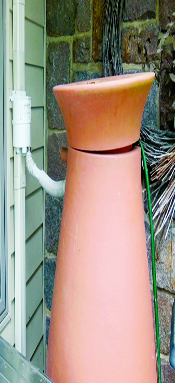Reserving Water

Bed rest. Doctor’s orders, after planting in the rain last week.
I count on cloudy, soon to be rain-filled days. It helps to get new plants successfully settled. I even have a raincoat that hangs in the garage for those special days.
I am a big fan of the power of rain water. Over-wintered plants looking like they are almost gone revive after a few days of rain on my deck. Outside plants respond better to rain water than chlorinated city water so I reserve a few gallons for seedling planting to give them a good start. Chlorine stunts plant growth.
Rainwater is highly oxygenated. It is free of salts and other compounds that accumulate in city water and settle into soil. When using rainwater in the garden, the rain water dilutes the impact of that sediment, making plants healthier, stronger and drought-tolerant.
I didn’t know that when in 1982, my husband-at-the-time and I built our home on the side of a limestone hill. I did know keeping water away from the house was important so I talked to the contractor about placing downspout ends to push rain away from the house. Since I was planning a low maintenance garden, having the garden water itself seemed like a good idea.
Once installed, the down spouts were given rock bowls so they slowed down soil erosion and rock-lined channels guided water to the bottom of the property. We saw a significant increase in volunteer frogs.
A few years later, a bonus check at work funded my rain detention pond on the backside of my house. At that time, we connected the gutters to pipes that took rainwater from the gutter system straight into the pond. Collecting the water away from the house kept my basement dry and provided area wildlife a popular drinking spot. I remember sitting pond side one morning and watching a mama field mouse carry a baby down the rocky ledge to get a drink.
Now I have an even better system.
After installing six-inch gutters where the roof line spilled the most rain, the downspouts are now tied to two, 65-gallon rain barrels. They are terra cotta plastic with a spigot at the bottom and a hose attachment so the water is easily removed. One is on my deck so I can easily water potted plants; the other one is next to my herb garden off my back porch.
The downspouts have a rain reserve system that fills up each of the rain barrels.
Once full, a flap closes and the rain gets funneled to two water totes set up under my deck.
When those totes are full, the rain water continues down the downspouts to my back pond. There’s a spigot on the totes for easy access and a hose attachment.
Once a little pump is in, the water totes will refill the rain barrel on the top deck.
Oh. And I won’t forget to wear my rain coat the next time I plant in rain.
Charlotte Ekker Wiggins is a beekeeper, gardener and sometimes cook. Published by El Dorado Springs Sun once in print and online with author’s permission. Copyright 2017, all rights reserved. This column may not be reprinted, republished or otherwise distributed without author’s permission. Contact Charlotte at gardeningcharlotte at gmail dot com.

NATURE DOES THE WORK – The rain barrel on my deck is now gravity-fed by a hose attached to the downspout allowing rain water to fill it up. Once full, rain continues through the downspout to fill water totes under my deck.

DRY DAY SUPPLY – The two water totes under my deck are starting to collect some of our late spring rain for later garden use. Once full, the overflow will continue through the downspout to the back pond. (Photos by Charlotte Ekker Wiggins).



Facebook Comments